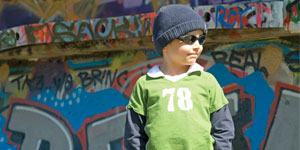Health
4 min Read
Does your child need glasses?

February 20, 2013
Health
4 min Read

February 20, 2013

 You can’t rely on young children to alert you to vision problems, so play offense, rather than defense. The Canadian Pediatric Society says eye anatomy and function should be
You can’t rely on young children to alert you to vision problems, so play offense, rather than defense. The Canadian Pediatric Society says eye anatomy and function should be
checked at regular and well-child visits with the family doctor. Visual acuity should be assessed if your preschooler complains about not being able to see well or you notice signs of vision problems (see below).
Optometrists encourage annual visits from age three. “A young child may not be able to articulate that they are seeing double or not seeing properly out of one eye,” says Dr. Alyssa Markowitz, optometrist and owner of Liberty Village Eye Care in Toronto. (Children under 19 are covered for routine eye exams from an optometrist by provincial health care plans.)
When children begin to learn to read, visual problems can become apparent, and it is even more important to see an optometrist. “By the time your children are seven or eight, they are not just learning to read, but are reading to learn. This is a critical stage in educational success,” says Dr. Markowitz.
If you notice your child is having difficulty with gross or fine motor skills, a good place to start would be a comprehensive visual assessment with an optometrist. Ask your family doctor for a referral if you’re having trouble finding one. Be sure that your child’s basic visual system is working and that your child has clear single vision up close and far away. If the visual assessment is considered normal, then you may want to consider more testing to rule out other concerns.
Aside from difficulty reading or poor performance in school, there are other signs of poor vision to look for, including:
Some or all of the above can be signs of amblyopia (or vision loss), which can be caused by strabismus (lazy eye) or a refractive error (inability for the eye to focus on an image). Refractive errors are usually corrected with glasses.
If your child does require glasses, he or she will need to visit the optometrist regularly. When it comes to vision, some kids are stable for a long time, while others can have changes in their eyes within six months.
You may have some concerns when it comes to buying your child’s first pair of
glasses. Dr. Markowitz has these tips:
Originally published in ParentsCanada magazine, February/March 2013.